Garlic planting is a rewarding experience for gardeners of all levels. With its rich history and versatility, garlic is a popular choice for home gardens. It’s easy to grow, hardy, and requires minimal care, making it an ideal crop for beginners and seasoned gardeners alike. This guide provides a comprehensive overview of garlic cultivation, covering everything from soil preparation to harvesting. Whether you’re looking to enhance your cooking or explore sustainable gardening, garlic is a fantastic addition to any garden. Let’s dive into the world of garlic planting and discover how to grow this incredible bulb successfully!
1.1 Importance of Garlic in Gardening
Garlic is a cornerstone in many gardens due to its ease of growth and versatility. It requires minimal care, making it ideal for both novice and experienced gardeners. Garlic’s natural pest-resistance reduces the need for pesticides, promoting a healthier ecosystem. Its long storage life ensures a steady supply for culinary use. Additionally, garlic enhances soil health and can be used as a natural repellent for garden pests. These qualities make it a valuable and sustainable addition to any garden, offering both practical and culinary benefits for growers.
1.2 Brief History of Garlic Cultivation
Garlic has been cultivated for thousands of years, with its origins tracing back to Central Asia. It was highly valued by ancient civilizations, including the Egyptians, Greeks, and Romans, for its culinary and medicinal properties. Over time, garlic spread globally, with different regions developing unique varieties. Today, garlic remains a fundamental crop worldwide, cherished for its flavor, health benefits, and ease of cultivation. Its enduring popularity is a testament to its adaptability and the diverse ways it enriches gardens and kitchens across cultures and centuries.
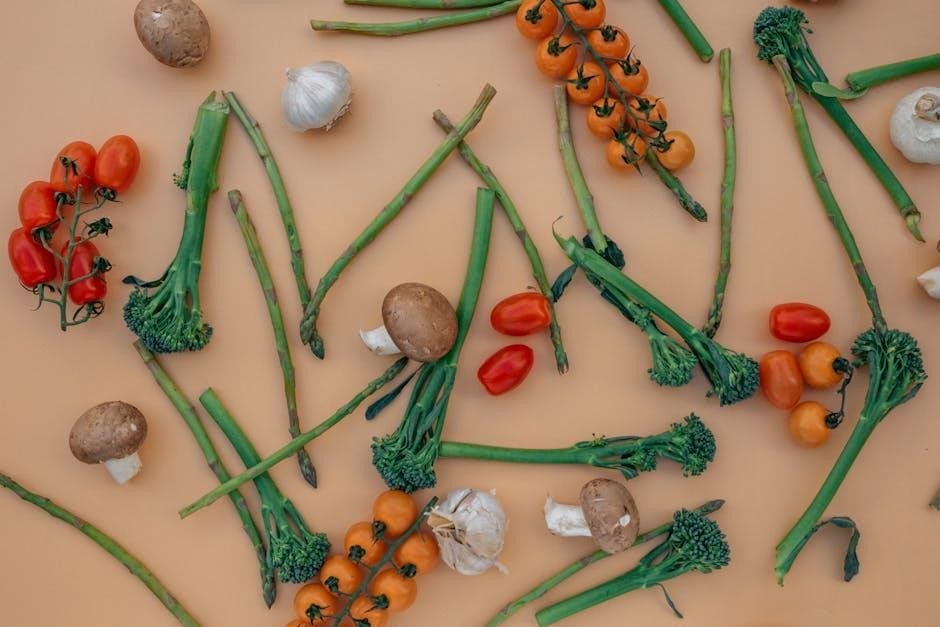
Types of Garlic
Garlic comes in diverse varieties, each with unique flavors, sizes, and growing characteristics. From robust hardneck to mild softneck and large elephant garlic, there’s a type for every gardener and recipe.
2.1 Hardneck Garlic
Hardneck garlic is known for its robust, complex flavors and distinctive hard central stem. It typically produces fewer cloves per bulb, but they are larger and have a longer shelf life. Hardneck varieties are more sensitive to climate and thrive in cooler regions with well-drained soil. They also tend to form scapes, which can be harvested and used in cooking. Popular hardneck varieties include ‘Rocambole’ and ‘Porcelain,’ offering a range of flavors from spicy to nutty. These varieties are ideal for gardeners in northern climates with cold winters.
2.2 Softneck Garlic
Softneck garlic is a popular variety known for its soft, flexible central stem, making it ideal for braiding. It has a longer shelf life and is more adaptable to warmer climates compared to hardneck garlic. Softneck varieties, like ‘Silverskin’ and ‘Artichoke,’ often produce smaller cloves but higher yields. They are easier to grow in diverse conditions and are commonly found in supermarkets. With a milder flavor profile, softneck garlic is a great choice for gardeners in southern regions or those new to growing garlic due to its ease of cultivation and versatility.
2.3 Elephant Garlic
Elephant garlic, though technically a leek, is often classified with garlic due to its similar appearance and culinary use. It boasts large, mild-flavored cloves with a sweet, nutty taste. Ideal for roasting, elephant garlic adds a unique dimension to dishes. Plant bulbs 3 inches deep and 8-12 inches apart, as they grow larger than traditional garlic. Mulching is recommended to prevent soil heaving. Its size and flavor make it a standout choice for gardeners seeking variety in their harvest. This variety is perfect for those looking to try something different and delicious in their garlic-growing journey.
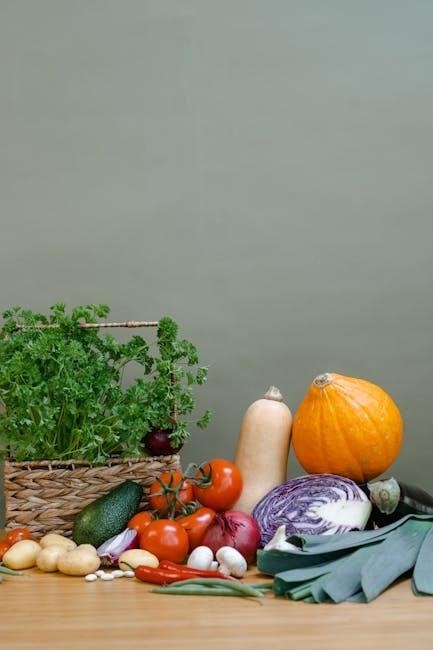
Soil Preparation
Garlic thrives in well-draining, fertile soil with a neutral pH of 6-7. Incorporate compost or aged manure to enrich the soil. Avoid waterlogged areas to prevent disease.
3.1 Choosing the Right Location
Garlic requires a sunny, well-draining location to thrive. Select a spot that receives 6-8 hours of direct sunlight daily. Avoid shaded areas, as they can lead to poor growth. The ideal location should have fertile, neutral soil with a pH between 6-7. Raised beds are excellent for garlic due to improved drainage. Ensure the area is level to prevent water pooling, which can rot the bulbs. Avoid planting in low-lying areas where water may collect. Proper site selection is crucial for healthy growth and bulb development.
3.2 Soil Type and pH Requirements
Garlic thrives in well-draining, fertile soil with a pH between 6.0 and 7.0. Avoid heavy clay or waterlogged soils, as they can lead to rot and poor growth. Sandy loam or silty loam soils are ideal, as they drain excess water while retaining essential nutrients. Test your soil pH and amend it if necessary. Balanced soil conditions promote healthy root development and bulb formation. Proper soil preparation ensures robust growth and maximizes your garlic harvest. Ensure the soil is loose and well-aerated to support the bulb’s natural expansion underground.
3.3 Fertilization and Composting
Garlic is a heavy feeder and benefits from rich, fertile soil. Incorporate compost or aged manure before planting to boost nutrient levels. Avoid fresh manure, as it can burn the roots. During the growing season, side-dress with a balanced fertilizer (10-10-10) when the plants are about 6 inches tall. Over-fertilization can lead to excessive foliage and smaller bulbs. Maintain a balanced approach to fertilization to promote healthy growth and maximize bulb size. Proper composting and fertilization ensure a robust and flavorful harvest.
Planting Process
Garlic planting involves selecting healthy cloves, preparing the soil, and planting at the right depth and spacing. This step ensures proper growth and maximizes yield.
4.1 Best Time to Plant Garlic
The optimal time to plant garlic is in the fall, about 6-8 weeks before the first frost. This allows the cloves to establish themselves before winter. The garlic requires a cold period to form bulbs, with an 8-month growth cycle. In cooler climates, early spring planting is also effective. Avoid planting too late in the fall to ensure proper establishment. This timing ensures healthy growth and maximizes your harvest.
4.2 Planting Depth and Spacing
Plant garlic cloves 2 inches deep, with the pointed end facing upward. Space standard varieties 4-6 inches apart in rows, while elephant garlic requires 8-12 inches between cloves. Rows should be 12-18 inches apart to allow for proper growth and air circulation. Proper spacing ensures bulbs have enough room to mature and reduces the risk of disease. Deeper planting in lighter soils can yield larger bulbs, but avoid over-deep planting to prevent stunted growth.
4.3 Handling and Planting Garlic Cloves
Handle garlic cloves gently to avoid damage. Select healthy, firm cloves from disease-free bulbs. Separate cloves just before planting to ensure freshness. Plant each clove with the pointed end facing upward and the basal plate (flat end) downward. This orientation promotes proper root development. Use a measuring guide, like the length of pruning shears, to maintain consistent spacing. Avoid breaking or bruising the cloves, as this can lead to rot or poor growth. Proper handling ensures healthy establishment and robust bulb formation.

Garlic Care and Maintenance
Garlic requires consistent moisture, full sun, and well-draining soil for optimal growth. Regular mulching helps retain moisture and suppress weeds. Monitor temperature fluctuations to ensure healthy bulb formation.
5.1 Watering Requirements
Garlic needs consistent moisture, especially during the growing season. Water deeply once or twice a week, depending on weather conditions. Avoid overwatering, as it can lead to rot. Well-draining soil is essential to prevent waterlogged bulbs. During the first few months, keep the soil moist but not soggy. Reduce watering as the plants mature, typically in late spring or early summer, to allow the bulbs to dry for harvesting. Proper watering ensures healthy growth and flavorful bulbs.
5.2 Mulching Techniques
Mulching is a key practice for growing garlic, as it retains moisture, suppresses weeds, and regulates soil temperature. Apply a 2-3 inch layer of organic mulch like straw, wood chips, or grass clippings after planting. Avoid heavy mulching that might suffocate the plants. Replenish the mulch as needed during the growing season. This technique promotes healthy bulb formation and reduces maintenance. Mulching also helps prevent soil heaving during winter, ensuring the cloves stay rooted and protected.
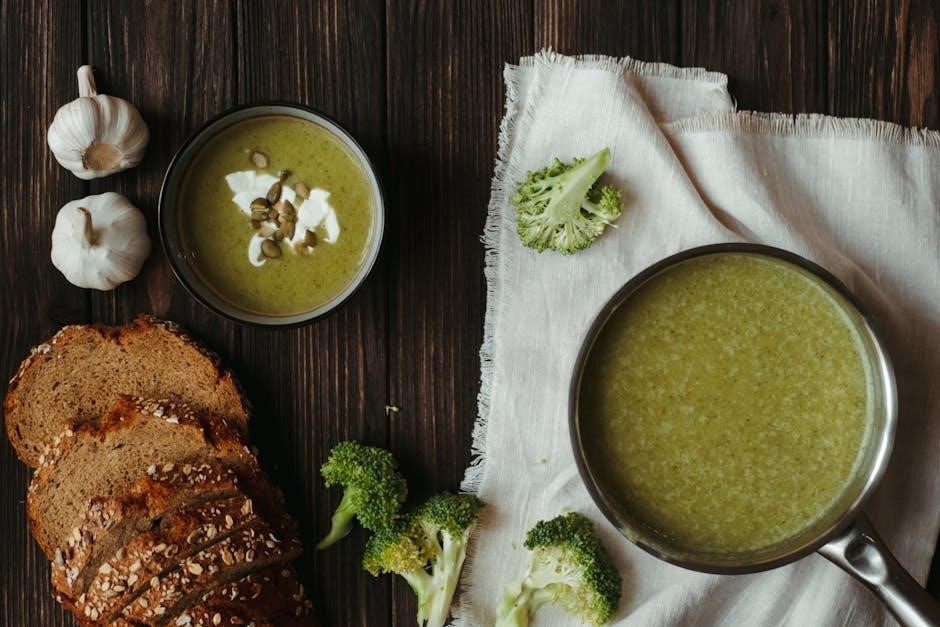
5.3 Sunlight and Temperature Needs
Garlic thrives in full sun, requiring 6 to 8 hours of direct sunlight daily for optimal growth. It prefers well-draining soil and a neutral pH between 6 and 7. Garlic needs a period of cold weather to form bulbs, making fall planting ideal in cooler climates. In warmer climates, it can be planted in early spring. Temperatures between 40°F and 70°F promote healthy bulb development. Avoid planting in low-lying areas where water may collect, as this can lead to rot. Raised beds are ideal for improving drainage and ensuring even sunlight distribution.
Common Challenges
Garlic growers often face challenges like pests, diseases, and adverse weather. These issues can reduce yields and affect bulb quality, requiring proactive management strategies to ensure a successful harvest.
6.1 Pest Control
Garlic plants can be susceptible to pests like aphids, mites, and nematodes, which can harm bulb production. Regular monitoring is essential to spot infestations early. Use natural methods such as introducing predatory mites or spraying neem oil to control outbreaks. Crop rotation and maintaining clean, healthy soil also help deter pests. Avoid overwatering, as moist conditions attract pests. Hand-picking or using diatomaceous earth can effectively manage infestations without harming beneficial insects. Addressing pest issues promptly ensures healthy growth and maximizes your garlic harvest.
6.2 Disease Management
Garlic plants are prone to diseases such as powdery mildew, rust, and rot, which can significantly reduce yields. To prevent these issues, ensure good air circulation by spacing plants appropriately and avoid overwatering. Regularly inspect plants for signs of disease, and treat affected areas with organic fungicides or copper-based solutions. Rotate crops annually to break disease cycles and maintain healthy soil. Removing and disposing of infected plants promptly can prevent the spread of disease. Healthy soil and proper planting techniques also play a crucial role in minimizing the risk of disease in garlic crops.
6.3 Weather and Climate Considerations
Garlic thrives in temperate climates with moderate weather conditions. It requires a cold period to form bulbs, making fall planting ideal in regions with cool winters. Avoid areas with standing water, as garlic is susceptible to root rot in wet conditions. Ensure full sun exposure, as shaded areas can reduce yields. Garlic prefers consistent moisture but drains poorly in heavy rain. Regions with harsh, prolonged heat or excessive humidity may struggle with garlic cultivation. Planting in early spring or late summer can also work, depending on local weather patterns and variety requirements.
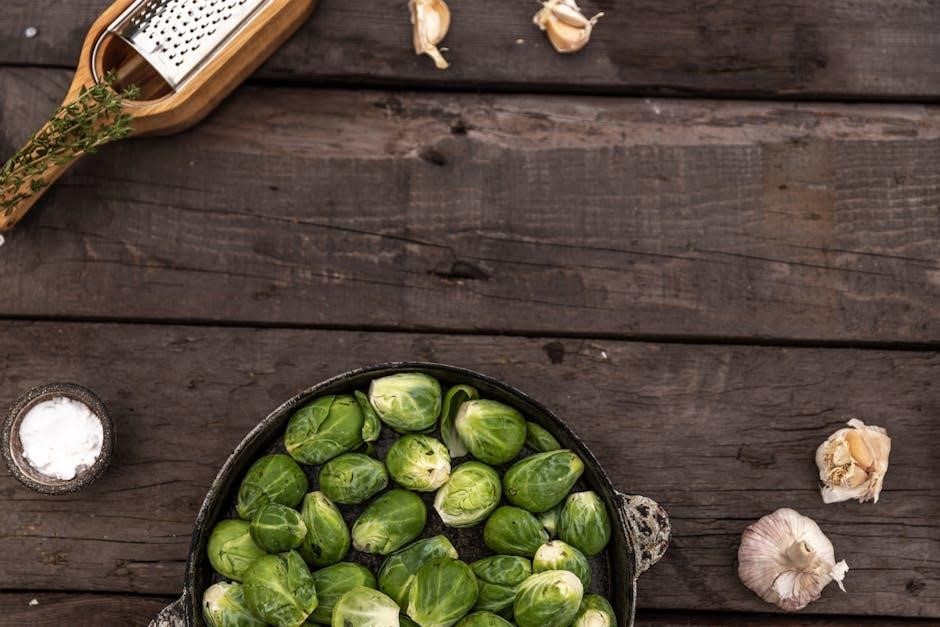
Harvesting Garlic
Garlic is ready to harvest when leaves yellow and tops begin to dry. Use a garden fork to carefully dig up bulbs, avoiding damage to the cloves.
7.1 Signs of Readiness
Garlic is ready to harvest when the leaves turn yellow and begin to dry, signaling that the bulbs have reached maturity. The tops will start to fall over, and the necks of the plants will become brittle. This usually occurs around late summer, typically 8-9 months after planting. Checking the bulbs by gently digging around them with a fork can confirm readiness. Proper timing ensures the bulbs are fully formed and flavorful, avoiding immature or overripe garlic.
7.2 Proper Harvesting Techniques
Harvest garlic by carefully loosening the soil around the bulbs with a garden fork, taking care not to pierce or damage them. Gently lift the bulbs out of the ground, working from the base of the plant. Avoid pulling the stems, as this can cause the bulbs to break apart. Once harvested, lay the bulbs out to dry further in a shaded, well-ventilated area or in the sun for a few days. Brush off any remaining soil and trim the roots and tops for storage.
7.3 Post-Harvest Care
After harvesting, allow garlic bulbs to cure in a shaded, well-ventilated area or in the sun for a few days. This process dries the outer layers, preparing them for storage and preventing rot. Keep the bulbs dry to avoid moisture, which can lead to spoilage. Once cured, trim the roots and tops neatly for storage. Handle the bulbs gently to avoid damage, ensuring they remain fresh and ready for use or long-term preservation.

Storing Garlic
Store garlic in a cool, dry place with good ventilation. Use paper bags or breathable containers. Avoid airtight containers and refrigeration for best preservation.
8.1 Short-Term Storage Methods
For short-term storage, garlic can be kept in a cool, dry place with good air circulation. Use paper bags or breathable containers to maintain humidity and prevent rot. Avoid storing in airtight containers or plastic bags, as they can trap moisture and promote mold growth. Garlic can also be stored in a ventilated area at room temperature for up to a month. Proper ventilation is key to preserving freshness and preventing spoilage during short-term storage periods.
8.2 Long-Term Storage Techniques
For long-term storage, garlic should be kept in a cool, dark, and dry place with consistent temperatures between 32°F and 40°F (0°C to 4°C). Store bulbs in paper bags, mesh bags, or ventilated containers to maintain airflow. Freezing is another effective method: peel cloves, chop or leave whole, and store in airtight containers or freezer bags. Properly stored garlic can last up to 8 months. Regularly check for sprouting or mold and remove affected bulbs to preserve the rest.
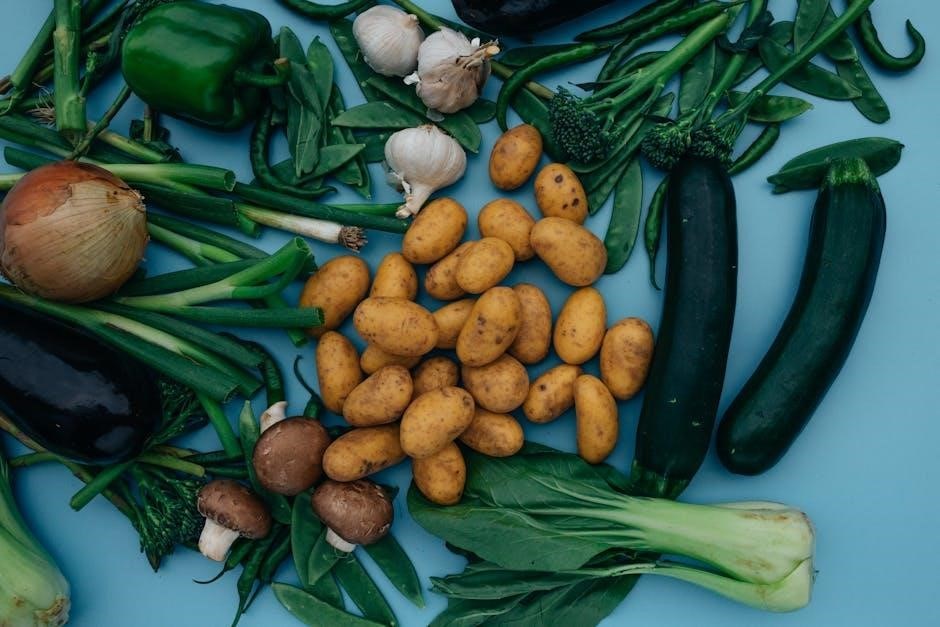
Advanced Garlic Growing Techniques
Explore advanced methods like companion planting with herbs and flowers to improve growth and pest resistance. Try growing garlic in containers for space-saving and enhanced portability. These techniques elevate your garlic cultivation to the next level.
9.1 Companion Planting
Companion planting enhances garlic growth by deterring pests and improving soil health. Pair garlic with herbs like rosemary or sage to repel pests naturally. Marigolds and calendula attract beneficial insects, creating a balanced ecosystem. Certain flowers and vegetables, such as nasturtiums or spinach, complement garlic growth. Avoid planting garlic near beans or peas, as they can hinder each other’s development. This technique promotes biodiversity and optimizes garden space, making it a valuable advanced strategy for garlic cultivation. It’s a simple yet effective way to boost your harvest’s success.
9.2 Growing Garlic in Containers
Garlic thrives in containers, offering a convenient way to grow this versatile crop. Choose containers with good drainage, ensuring a minimum depth of 6-8 inches. Plant individual cloves 4-6 inches apart in well-draining, fertile soil. Position containers in full sun for optimal growth. Water regularly, keeping the soil moist but not waterlogged. Mulch can help retain moisture and suppress weeds. Harvest typically occurs in mid-summer when the tops yellow. Growing garlic in containers allows for better control over soil conditions and pest management, making it an excellent option for small spaces or urban gardens.